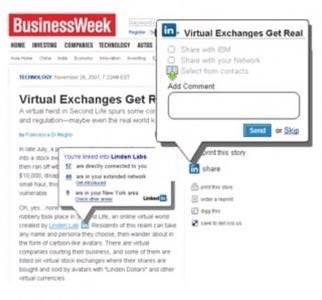LinkedIn just announced two new things: 1) a new Beta home page with a news feed; and 2) a developer API. Marshall Kirkpatrick covered the announcement this morning on Read/WriteWeb. I was given a background briefing by Adam Nash, Sr. Director of Product at LinkedIn, so in this post I’ll explore more about what the announcement means for LinkedIn’s user base – and how it compares to Facebook.

Although the news today is fairly ho-hum, what was new and interesting was that LinkedIn claimed a demographic that compared favorably to Wall Street Journal (WSJ) – LinkedIn has an audience that is both younger (41 vs 48) and richer ($106k vs $98K). LinkedIn was also naturally crowing about their growth (189% for year ending Oct. ‘07) and the chart from Nielsen which shows comparative Facebook growth at 125%. Note that Facebook growth is from a higher base and the law of large numbers applies, but Facebook has always crowed about their growth rates vs the larger MySpace, so they have to live with growth rate comparisons to LinkedIn now.
Getting that kind of growth with the younger/richer demographic is significant. What is the average income of a Facebook user? What is the growth rate of WSJ online?
If the rumours of negotiations with NewsCorp are true, I can imagine these numbers being used to some effect.
Four major use cases for LinkedIn
Before getting into the changes LinkedIn is announcing, it is interesting to look at the four major use cases for LinkedIn and use that to assess how well their direction fits the market needs:
Use Case # 1. Be found. If you want a better job or you want clients for your consulting business, updating your LinkedIn profile is one of the better uses of your time online. Yes your online presence is scattered across multiple sites, but for the business user LinkedIn is probably the number one site you have to pay attention to. You can also link from there to your site and Blog if you have one, so this works for early adopters as well as late adopters whose only presence is LinkedIn. There is one subtle benefit compared to job boards, which also plays to the next use case, which is that you don’t have to declare that you are looking for a job. You just say “Hi, this is me”. This strengthens your negotiating position with a new employer and does not upset your current employer.
Use Case # 2. Recruit. LinkedIn is used by recruiting firms but also by internal hiring managers. The one big benefit of LinkedIn vs job boards is that you can use LinkedIn to search for the candidate that is not actively looking. This is critical in a tight job market (which we have today). This kind of database is a key reason we have used external recruiters in the past. I asked if LinkedIn was a threat to recruiters and got the usual answer about “the ones who use LinkedIn to add value are doing great” – which means it is a threat to their current way of working. I imagine LinkedIn is a significant threat to traditional job boards.
Use Case # 3. Selling through contacts to avoid cold calls. My experience, amplified by speaking to a few other people who have used LinkedIn for this purpose, is that it is highly valuable up to Level 2 but no further. It is very useful to me to search for a particular company that I want to sell to, refine that by job title, and then see which of my contacts knows somebody there. Or I can search for a specific person as in “who do I know who knows Joe Bloggs”? This is the use case that got me interested in LinkedIn and I wrote more about the experience here. The point is it is useful only up to that level of separation. If I see Level 3, it is usually not worth the bother. That is when I am asking “who do I know who knows somebody who knows Joe Bloggs.” So this use case is limited to people with already strong networks that work across multiple domains.
Use Case # 4. Finding an expert “just in time”. This is a potentially big use case that LinkedIn is exploring, but it does not seem big today. There are many specialists doing this. For example, Gerson Lehman Group does this primarily for investors (Hedge Funds, Private Equity, Venture Capital) looking to find an expert in a market or technology; Gerson Lehman acts as a form of broker and the expert gets paid per hour. There are also examples in specific niches. This use case seems small today but it has big potential and it also impacts the other use cases as follows:
a) if I am looking for a job but don’t want to advertise that fact, I will be motivated to answer questions that show off my expertise and get me noticed.
b) ditto if I am a consultant or working in a consulting business
c) ditto if I am selling something where I want to engage in a conversation first that shows I know what I am talking about
So that creates a lot of motivation to answer questions; which should mean high quality answers which should mean more questions.
How LinkedIn’s announcement today relates to the 4 use cases
So what did LinkedIn announce today and how does it score against those 4 major use cases?
1. They announced a developer API. Note that “announced” does not mean available. I asked, “can we get documentation and start using it?” Answer, “no it is only an announcement”.
There was an intriguing screenshot from BusinessWeek showing a Company Name in an article with a little IN symbol; click on it and you see who you are connected to at that Company. That looks like a good traffic builder for LinkedIn (and a nice feature for BusinessWeek readers).

LinkedIn is clearly taking this carefully and that is probably sensible. They are in the OpenSocial camp and it is now clear that there are real implementation issues with that API (hardly surprising given the complexity of what OpenSocial is attempting). LinkedIn API appeals to big enterprise software players who have to get it right first time. This is not like the Facebook economy where the developers are tiny start-ups trying out quick hacks.
It will be interesting to see how this plays out. SalesForce.com would be the obvious integration but can the two “platforms” play well together? There are probably simpler discussions with HR/Recruitment management systems.
2. A new home page in Beta. The News feature is a bit of a damp squib I am afraid. Its only a news feed about your own company. As even the LinkedIn guy agreed, we have been using Google Alerts to do this for years.
Now if they were releasing a news feed about all my contacts, that I could filter as needed, that would be cool. But all I got for that suggestion was that it was part of the “road map” (or maybe the “vision” I cannot recall).
Lets be clear, LinkedIn is not targetting the early adopter crowd that comes to Read/WriteWeb. They are going after the mainstream business person who does not use RSS and so may find even this basic news service more reason to use LinkedIn. However I think they are getting this market wrong. The features they are adding are Facebook-like, they encourage me to spend more time inside LinkedIn, using their messaging for example. Sorry, but your average business guy hangs out in Outlook and Office; when they are online it is usually now some company Wiki or other collaboration tool. Another place to “visit” daily is way, way down the priority list along with untangling the phone cable.
Conclusion
If LinkedIn tries too hard to get people to spend time in their destination site. they will lose the early adopters who already want to consume RSS feeds in Start Pages. The later adopters who are professional networkers (biz dev guys or recruiters) may hang out regularly on LinkedIn, but that makes it way too one sided.
There seems to be a big hole between a) tools to get me to their destination site and b) API to be used by big enterprise applications. That gap could be easily filled by tools based on RSS and Pub/Sub technology. The amount of data LinkedIn has is perfectly suited to this type of technology.
That may leave LinkedIn with a business model issue, but the usual rule is to figure out what your community needs first and worry about business model monetization later.










